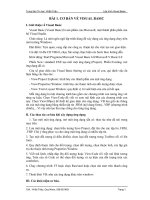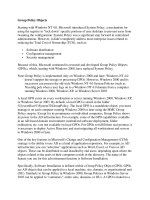Tài liệu WORCESTER ART MUSEUM ANNUAL ''''-- VOLUME 1 pptx
Bạn đang xem bản rút gọn của tài liệu. Xem và tải ngay bản đầy đủ của tài liệu tại đây (1.56 MB, 6 trang )
W"ORCESTER
ART
MUSEUM
ANNUAL
'
VOLUME
1.
The
Worcester
Art
Museum publishes two
periodicals.
The
Annual
is
devoted to the
study of the collections
and
to articles on
problems
of
research by members of the Staff
and
invited contributors. Announcement of
exhibitions, acknowledgment of gifts, and in-
formation rel
ating
to the various activities of
the institution are fully recorded
in
the
News
Bulletin
and
Calendar (published monthly
from October to May inclusive)
and
in
the
Annual
Report
of
the Trustees. Sustaining
Members recei
ve
these publications free. Spe-
cial subscription for Libraries for both the
Bulletin and the Annual,
$1.00
per year. All
inquiries may be addressed to the Secretary.
WORCESTER,
MASSACHUSETTS
PUBLISHED
BY
THE
TRUSTEES
COPYRIGHT
BY
THE
TRUSTEES
OF
THE
WORCESTER
ART
MUSEUM,
1936.
PRINTED
IN
WORCESTER,
MASSACHUSETTS
BY
THE
COlvU\l
ONWEALTH
PRESS.
ENGRAV
INGS BY
LAWTON-CUPIT
CO.
FIG. I EGYPTIAN SCULPTURE, FOURTH DYNASTY
Acquired in
1935
AN
EGYPTIAN
SCULPTURE
OF
THE
FOURTH
DYNASTY
BY
PERRY
B.
COTT
Several years ago,
in
1931,
the Museum
ac-
quired the large relief of a nobleman
hunting
on the banks of the Nile. Until that time the
Egyptian collections had been lacking in
ob
-
jects of monumental proportions.
Now
it
is
a
pleasure to record the acquisition of another
outstanding work of art in this field, the life-
size torso of a woman carved of
Turah
lime-
stone (Fig.
I).
It
is
usually conceded that the finest Egyp-
tian sculpture was produced during the
Old
Kingdom (3400-2475 B.C.)
when
artistic activ-
ity was directed
to
the construction of the
pyramids and the adornment of tombs.
In
its
early stages sculpture of this period betrays
certain features of archaism but it was not long
before artists attained to a complete mastery
of their material and a mature style.
It
is
to
this epoch of consummate sculptural expres-
sion that the newly acquired Worcester torso
belongs.
Our
figure was originally part of a group,
doubtless a pair, representing a
man
and wife.
Thi
s
is
indicated by the fact that the sculpture
is
not free-standing, being bound to the stone
slab at the back
as
if leaning against a wall.
In
the photograph it
is
possible to make out the
broken edge of the slab, which formerly con-
nected the woman and her husband, at the
figure's right side.
The
man
was shown in a
standing or sitting position forming a composi-
tion comparable to that of
King
Mycerinus and
his wife
(IV
Dynasty) in the Museum of Fine
Arts, Boston, or the Family Group (Fig.
2), of
the same dynasty,
in
the Cairo Museum (num-
ber
55).
The
fracture at the right armpit of our
figure makes it impossible to know whether
she held her
arm
resting upon the shoulder of
her consort or around his waist.
The
most striking features of our sculpture
are the unusually fine quality of carving and
the delicate, sensuous modelling of the torso.
Such quality
is
comparatively rare in Egyptian
sculpture
and
suggests that the sculptor was
working under royal orders.
The
woman must
certainly have been a member of the high
nobility if not of the royal family itself.
The
figure
is
clothed in a long, simple dress
falling from the shoulders to a point above the
ankles.
The
thinness of the material, probably
a fine white linen, permitted the artist to ren-
der the anatomical structure with surprising
faithfulness to nature. Surviving specimens of
royal linens are of such exquisite fineness that
it
is
difficult to distinguish
them
from silk and
th
e limbs of the wearer could easily be dis-
cerned through the fabric.
The
extreme sub-
tlety with which breasts, abdomen and legs are
treated conveys a sense of pulsating vitality
and, in spite of the sculptor's adherence to the
Egyptian
conventions-the
medial axis which
divides the figure symmetrically, the left arm
held rigidly to the side and the left leg slightly
advanced-the
torso
is
full of potential move-
ment.
The
woman must originally have worn
the usual wig of the period since the lower
portion of its curled strands of hair are to
be
seen above the shoulders, at the back.
[
17
]
WORCESTER
ART
MUSEUM
ANNUAL
FIG. 2 FAMILY GROUP, CAIRO
Egyptian sculpture was practical in its aim
in
that figures of this type were not made for
public exhibition but were intended for the
tomb in order that they might be of direct
advantage to the deceased
in
the life hereafter.
The
tomb or mastaba was a massive oblong of
masonry containing three separate and essential
elements: a vertical pit ending below in the
funeral chamber where the
mummy
was kept,
and a walled chamber, the serdab, where the
images or statues of the deceased are preserved
until they are visited by the
Soul (Ba). Both of
these rooms were walled up after burial and the
only accessible compartment within the tomb
was the chapel, the third element, which was
open
to
kinsfolk, friends and the priests who
paid worship and offerings.
To
enable the soul
of the deceased to recognize and
"enter" the
image and thus prolong its future life it was
imperative that the sculptor create
as
living a
statue
as
possible of his subject, who
is
always
represented in the bloom of youth.
To
heighten
the effect of realism the sculpture was invaria-
[
18
]
bly painted with appropriate tones for flesh,
garments and jewelry.
On
our figure, however,
no traces of painting have remained.
The
immediate circle of the king, his family,
friends and officials constituted a class of priv-
ileged persons.
U suall y each family had a tomb,
generally in the vicinity of the pyramid of the
pharaoh and often built at his expense. These
tombs formed the royal cemeteries such
as
those excavated at Gizeh, Saqquara and Me-
dum. Although positive evidence
is
lacking,
our figure
is
reported to have been found in
excavations
in
the vicinity of the Great Pyra-
mid of Gizeh. Stylistic parallels to the W orces-
ter torso are to be found
in
several other
sculptures of the same period, notably in the
female figure
in
the Family Group
in
Cairo,
mentioned above, and a group statuette (Fig. 3)
from Gizeh representing Queen Meresankh
III
with her mother, Hetep-heres II, respectively
granddaughter and daughter of Cheops, in the
Museum of Fine Arts, Boston.
It
may
be
fairly
said, however, that neither of
these
is
so
fine
in
quality.
FIG.3
GROUP STATUETTE, BOSTON









